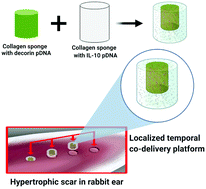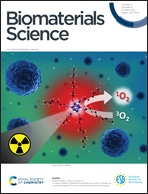Localized temporal co-delivery of interleukin 10 and decorin genes using amediated by collagen-based biphasic scaffold modulates the expression of TGF-β1/β2 in a rabbit ear hypertrophic scarring model†
Abstract
Hypertrophic scarring (HS) is an intractable complication associated with cutaneous wound healing. Although transforming growth factor β1 (TGF-β1) has long been documented as a central regulatory cytokine in fibrogenesis and fibroplasia, there is currently no cure. Gene therapy is emerging as a powerful tool to attenuate the overexpression of TGF-β1 and its signaling activities. An effective approach may require transferring multiple genes to regulate different aspects of TGF-β1 signaling activities in a Spatio-temporal manner. Herein we report the additive anti-fibrotic effects of two plasmid DNAs encoding interleukin 10 (IL-10) and decorin (DCN) co-delivered via a biphasic 3D collagen scaffold reservoir platform. Combined gene therapy significantly attenuated inflammation and extracellular matrix components’ accumulation in a rabbit ear ulcer model; and suppressed the expressions of genes associated with fibrogenesis, including collagen type I, as well as TGF-β1 and TGF-β2, while enhancing the genes commonly associated with regenerative healing including collagen type III. These findings may serve to provide a non-viral gene therapy platform that is safe, optimized, and effective to deliver multiple genes onto the diseased tissue in a wider range of tissue fibrosis-related maladies.



 Please wait while we load your content...
Please wait while we load your content...